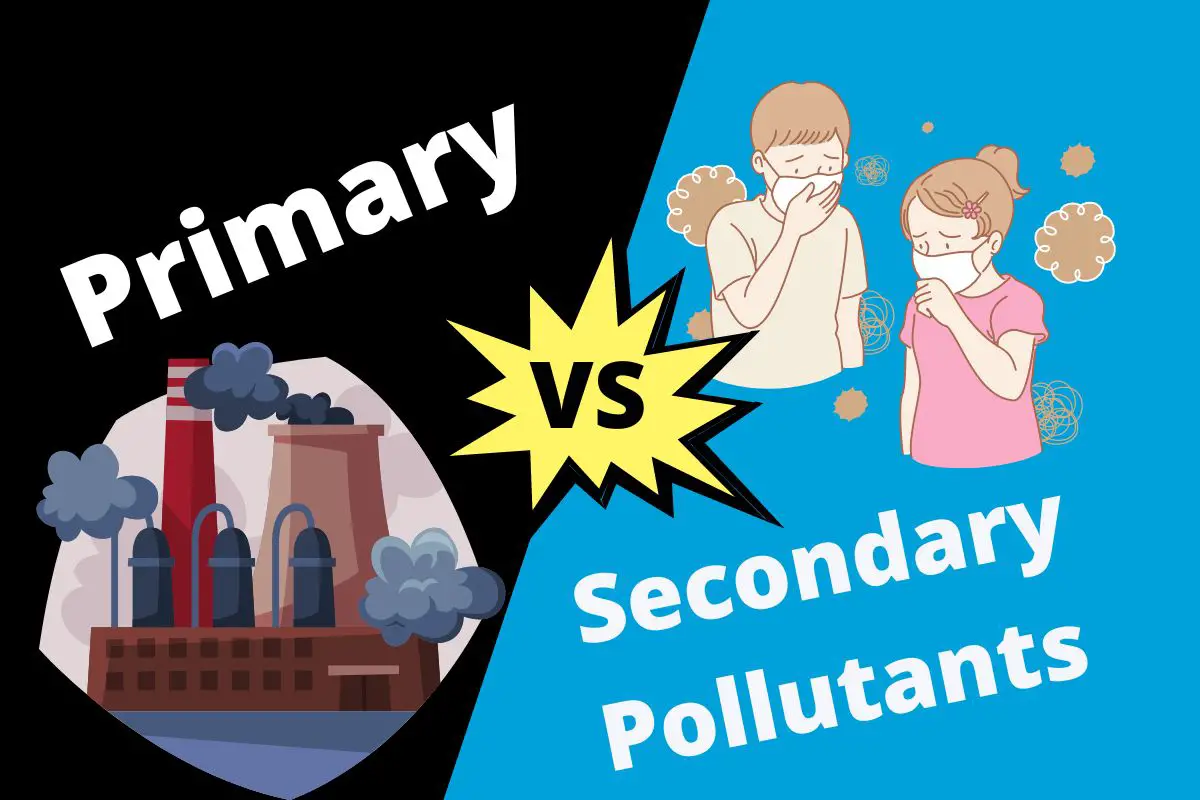Primary pollutants are directly emitted into the environment. These can come either from natural sources or anthropogenic sources. Secondary pollutants are not direct emissions from a particular source but result from chemical reactions between the primary pollutants.
There are hundreds of pollutants that are harmful to us and our environment. We can divide them into primary and secondary pollutants.
Table of Contents
Primary Pollutants vs Secondary Pollutants
| Primary Pollutants | vs | Secondary Pollutants |
| Primary pollutants are directly emitted into the environment | Definition | Result of chemical reactions among the primary pollutants |
| These are unstable pollutants | Status | These are stable or inert pollutants |
| Primary pollutants damage living organisms | Impact on the Environment | Secondary pollutants damage the ecosystem |
| These can impact us either directly or indirectly (by forming secondary pollutants) | Impact on Human Beings | These effects us directly |
| Motor vehicles, power plants, refineries, factories, and other industrial facilities, wood burning, and fireplaces. Natural sources like- wildfire, wind-blown dust, volcanoes, etc | Sources | Secondary particulate matter, photochemical oxidants |
| Carbon monoxide (CO), sulfur dioxide (SO2), nitrogen oxide (NOx), and particulate matter (PM). | Examples | Secondary particulate matter, photochemical oxidants (nitrogen dioxide, ozone, peroxy nitrates, sulfur trioxide, etc.), nutrient enrichment compounds, smog (smoke + fog), etc. |
| It can be controlled through the reduction of anthropogenic emissions | Controlling means | Complicated to control as it requires the understanding of chemical reactions and stopping them from taking place |
What are Primary Pollutants?
Primary pollutants are air pollutants that are directly emitted into the environment. Both natural (sand storms, volcanic eruptions) and man-made sources (vehicles, industries, etc.) can cause these types of pollutants.
Primary pollutants are the sources of other types of pollution.

Common Primary Pollutants
- Sulfur dioxide (SO2)
- Carbon monoxide (CO)
- Nitrogen dioxide (NOx)
- Volatile organic compounds ((VOCs)
- Particulate matter (PM)
- Carbon dioxide (CO2)
- Mercury (Hg)
- Di-hydrogen sulfide (H2S)
- Lead (Pb)
Sulfur Dioxide (SO2)
Sulfur dioxide has a powerful odor, and the gas emits from fuel combustion and processing mineral ores containing sulfur.
If you’re exposed directly to SO2, you may experience severe respiratory problems. When SO2 comes in contact with water, it may lead to acid rain.
Nitrogen Oxide (NOx)
The main source of nitrogen oxide is fossil fuel combustion. This includes diesel, petroleum, gasoline, etc.
Microbial activity in agriculture, like synthetic fertilizers, is another cause of NOx emissions. Being exposed to NOx may cause inflammation in the respiratory tract.
Carbon Monoxide (CO)
Fossil fuel combustion, such as biomass fuels, gasoline, diesel engines, and forest fires are the main sources of carbon monoxide.
This odorless gas is very toxic for humans, and exposure to it may cause unconsciousness, heart risks, etc.
What are Secondary Pollutants?
When chemical or physical interaction among primary pollutants or other atmospheric components occurs, they transform into secondary pollutants.
Secondary pollutants are not immediately visible on the materials they affect, but these are as harmful as the primary ones. The accumulation of secondary pollutants may happen over the years, and their impact may take years to notice.
Secondary particulate matter and photochemical oxidants are the two major causes of secondary pollutants.
Secondary Particulate Matter
Secondary particulate matter can cause chemical reactions, condensation of gases, and coagulation of different primary particles. The two main pollutants that lead to secondary particulate matter are nitrogen oxides and sulfur dioxide.
Photochemical Oxidants
When photochemical reactions involving sunlight, sulfur dioxide, nitrogen oxide, hydrogen peroxide, acids, peroxyacetyl nitrate, and other volatile components occur, it produces photochemical oxidants. Exposure to these components may cause lung disease, asthma, bronchitis, etc.
Difference Between Primary and Secondary Pollutants
Sources
Primary Pollutants
- Motor vehicles
- Power plants
- Refineries
- Factories
- Other industrial facilities, wood burning, and fireplaces.
- Wildfires
- Wind-blown dust
- Volcanoes
Pollution Impact
Both primary and secondary pollutants harmfully impact our ecosystem.
The effect of primary pollutants can be both direct and indirect. For example, when we are exposed to a primary pollutant like sulfur dioxide, it affects our respiratory system. And an example of indirect impacts is acid rain.
Secondary pollutants are less harmful than primary pollutants and may take years to show their impact. But, that’s not the case with ozone levels because photoactivation makes the chemical process highly reactive and harmful.
If you’ve found this article interesting, check out our post comparing sea versus ocean.

